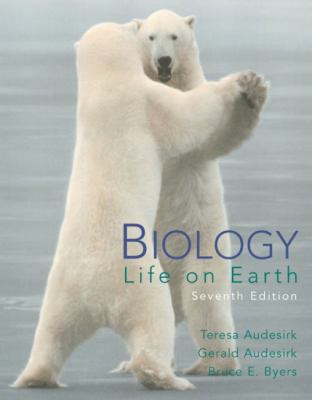405253
9780131005068
Biology; Life on Earth
by Teresa And gerald and Byers, Bruce E. Audesirk
About this item
- Condition: Acceptable
- Provider: alliedbookcompany Contact
- Provider Rating: 99%
- Ships From: Ligonier, IN
- Shipping: Standard, Expedited
- Comments: Book Leaves in 1 Business Day or Less! Leaves Same Day if Received by 2 pm EST! Cover is worn, mostly corners and binding. Acceptable. Multiple copies available. MI

About this item
- Condition: Good
- Provider: GoTextbooks Contact
- Provider Rating: 74%
- Ships From: Little Rock, AR
- Shipping: Standard
- Comments: Used books cannot guarantee unused access codes or working CD's! Ships fast!

Product details
- ISBN-13: 9780131005068
- ISBN: 0131005065
- Edition: Seventh Edition
- Publisher: Pearson/ Prentice Hall
AUTHOR
SUMMARY
Animal behavior, cloning, seed germination, stem cell research, biodiversity, population growth, artificial kidneys, global warming, pollination strategies, sequencing genomes--the staggering number of important and fascinating biological topics continues to grow. In fact, one can make a compelling argument that "biology" is no longer a single discipline. In the midst of this wealth of information, how does an instructor of an introductory course choose what to cover, and at what level to cover it? What basic concepts and principles form the foundation of biology? What topics are the most compelling to students? Which types of biological knowledge will best prepare them to make informed choices relating to their own lives and to the greater world that their personal choices impact? In talking to educators faced with these tough decisions, a single overriding consensus emerged: "We need to help our students become scientifically literate." Scientific literacy endows a student with the mental tools to cope with expanding knowledge. It requires a foundation of basic factual knowledge--a mental framework into which new information can be integrated. But it also encompasses the ability to grasp and evaluate information from the news and popular press. A scientifically literate individual does not think in isolated "soundbites," but recognizes the interrelatedness of concepts and the need to bring information from many areas to bear on an issue. A scientifically literate individual also needs to be able to use today's amazing resources, most significantly the Internet, to find accurate information; he or she must be able to distinguish true scientific information from pseudoscience. Biology: Life on EarthEffectively Manages a Wealth of Scientific Information Our seventh edition ofBiology: Life on Earth--which is more than a textbook, but rather a complete package of teaching aids for the instructor and learning aids for students--has been revised with three specific goals: To help instructors manage the presentation of biological information with the goal of producing scientifically literate students To help each student to acquire information according to his or her own learning style To help students relate this information to their own lives so as to understand its importance and relevance Biology: Life on Earth ... Is Organized Clearly and Uniformly Throughout each chapter, students will find aids that help them navigate through the information. "At a Glance" at the start of each chapter brings together the chapter's major subheadings and now includes the titles of Essays as well. Instructors can easily assign--and students can easily locate--key topics within the chapter. Major sections are introduced as questions to which the student will find answers in the section, while minor subheadings are presented as summary statements that reflect content. A crucial outgrowth of this organizational scheme is that it imparts an understanding of biology as a hierarchy of interrelated concepts, rather than a set of isolated, independent subjects. The "Summary of Key Concepts" pulls together important concepts using the major subheadings as an organizing feature. Both "At a Glance" and the "Summary of Key Concepts" use the heading-based numbering system featured within the chapters themselves, allowing instructors and students to move efficiently among the different components within a chapter. Information is integrated and easily managed within the total package. Media Activity tabs within each chapter direct the student to OneKey, which contains relevant activities, animations, and practice tests; the Media Activity numbers in the book correspond with OneKey for easy navigation. Detailed descriptions of each Media Activity are found at the end of each chapterTeresa And gerald and Byers, Bruce E. Audesirk is the author of 'Biology; Life on Earth' with ISBN 9780131005068 and ISBN 0131005065.
[read more]


